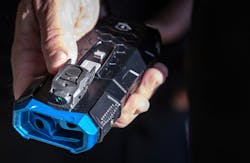Less lethal alternatives are getting a lot of attention in law enforcement as many agencies look for products that can incapacitate dangerous or noncompliant subjects and de-escalate scenarios. There are plenty of benefits to less lethal alternatives, including the fact that they give officers another means to control a situation before turning to lethal force. “Any time an officer doesn’t have to use lethal force, that’s going to be better for everybody,” says Sergeant Christopher Britt, Fort Worth Police Department (Texas). “No one wants to use lethal force. Any time an officer has used lethal force, there is a weight that that officer carries for the rest of his life.”
Although less lethal alternatives have been around for decades, they are constantly being improved to fit the officer and the climate of the times. Today’s agencies are looking for multi-use less lethal products and those that can be used at a greater distance all while keeping the safety of the subject and officer in mind. But there’s no ‘one-size-fits-all’ less lethal alternative—each product fills a certain niche depending on agency and officer needs. Proper testing and training with all less lethal products can help agencies learn the technology’s benefits and limitations.
Desirable features in less lethal options
Not only are agencies asking for the ability to engage at longer distances with their less lethal products, they are also asking for one piece of equipment to cover a wider array of situations. Carlson notes that having the ability to de-escalate a situation without excessive force is an important consideration as agencies deal with increased public scrutiny and review. “By having a non lethal option, force levels can be brought up to the level needed to stop the action before other lethal options have to be used.”
Changes to a law enforcement less lethal powerhouse
Axon, known for the TASER conducted energy weapon (CEW), recently revealed new developments to its next generation TASER weapon – the TASER 7 – intended to address several issues with previous iterations of the product.
In the past, several primary reasons TASER weapons were not always effective included misses, clothing disconnects and spread issues, says Steve Tuttle, Axon’s Principal, TASER CEW Sales. “You’d get a foot of spread for every 7 feet that these devices are away from you,” says Tuttle. “The challenge is that a lot of these officers think they are 7 feet away but if they extend their arms out, then they are at 5 feet. Right from the get-go we reduced the minimum spread required.” Now, Tuttle believes the company addressed the Achilles heel of the product with several new developments to the TASER 7.
First, Axon changed the probe by putting the wire inside the probe, ultimately changing the way it gets deployed. “Since we are unspooling wire from the probe it becomes much more accurate,” says Tuttle. “The probe can break away but the wire still stays attached and that’s really important when we talk about angled shots. That means we get better attainment with this probe, resulting in less clothing disconnects. It’s going to compress more clothing because the probe is heavier now, too. It’s coming out with two times the kinetic energy so now it can squish the thick jackets with the hopes of connecting the skin.” Additionally, the darts will be 28 percent faster.
The new TASER 7 comes with two sets of cartridges: a close-quarters and standoff cartridge to address spread issues, with 12 and 3.5 degrees of spread, respectively. Plus, it becomes more accurate at longer range. “With our older cartridges they were dropping at 12 to 14 feet, but with our redesign, the first place we start to see the cartridges drop off is 22 feet,” says Tuttle. Alongside probe changes the company introduced adaptive cross connect. “If you fire that cartridge twice you’re going to get four darts out,” explains Tuttle. “Electricity is driven between all contacts, which increases effectiveness and helps compensate for close probe spreads or clothing disconnects.”
Development of a new less lethal tool
What makes this device differ from other less lethal solutions out there? Norris says it’s pain-free. “How does a LEO deal with someone with autism who is being noncompliant?” he asks. “Today they have very few tools. This is a tool that would remotely restrain somebody. It’s like putting handcuffs on someone’s legs but from 20 feet away. Everything stops once they are wrapped and you can start figuring out what your next steps are.”
Chief Ed Hudak of Coral Gables Police Department (Fla.) believes that added to the less lethal toolbox, the BolaWrap can improve safety for both officers and those they are arresting. “What kills cops? Hands. This device gives my officers the opportunity to keep the hands in the pocket until they can get close enough to secure whatever is in that person’s hands or to see that there’s nothing there,” he says. “The officer can then use other techniques to handcuff the individual in a much more secure fashion. It is incumbent upon any chief, regardless of the size of your department, to look at every possible [less lethal] option to keep our officers safe.” Hudak stresses that the BolaWrap is an added tool in the less lethal toolbox and he has no intention of replacing the agency’s other less lethal alternatives such as electronic control devices. “Anybody will tell you that our jobs are not always pretty and we don’t get do-overs,” he notes. “Although I’m a firm believer in electronic control devices, if I can give my officers another option, especially in this climate, it would be disingenuous not to explore that option.”
Despite the development and advancements of less lethal products, agencies need to make training just as important as the less lethal product selection.
Combat the diminished value of training
According to less lethal expert Wes Doss, president and CEO of Khyber Training, there has been a lack of training in less lethal products in recent years. “Years ago there were so many structured programs out there, but today, that’s not the case.” He says it’s hard to explain why there’s a lack of education. “It’s almost like less lethal training has gone backwards, whether it’s the accidents that have happened or the shortcomings that have happened, or the overwhelming faith in a can of pepper spray as being the end-all, be-all.” When agencies don’t put the money and time into training, Doss notes that’s when performance issues happen. “Everything has a shortcoming and that’s something you have to make people painfully aware of,” he says. “Everyone has to understand that products aren’t perfect and you have to train to those limitations.”
Once you have instructors certified within your department, Doss recommends that the training within your department be continuous. “You’re preparing people to deploy these devices in the real world. When we skimp on training, all we are doing is setting ourselves up for failure. Look at the viability of each less lethal alternative. Spend time and do research on the device itself.”
About the Author

Adrienne Zimmer
Editor
Adrienne Zimmer was the Editor of Law Enforcement Technology magazine, a monthly business-to-business publication that covers technology trends and best practices for public safety managers from 2017 to 2019. LET is part of Officer Media Group, which also publishes Law Enforcement Product News and Officer.com. Adrienne has been in publishing since 2013.




